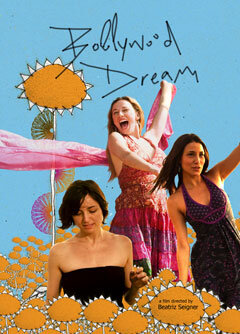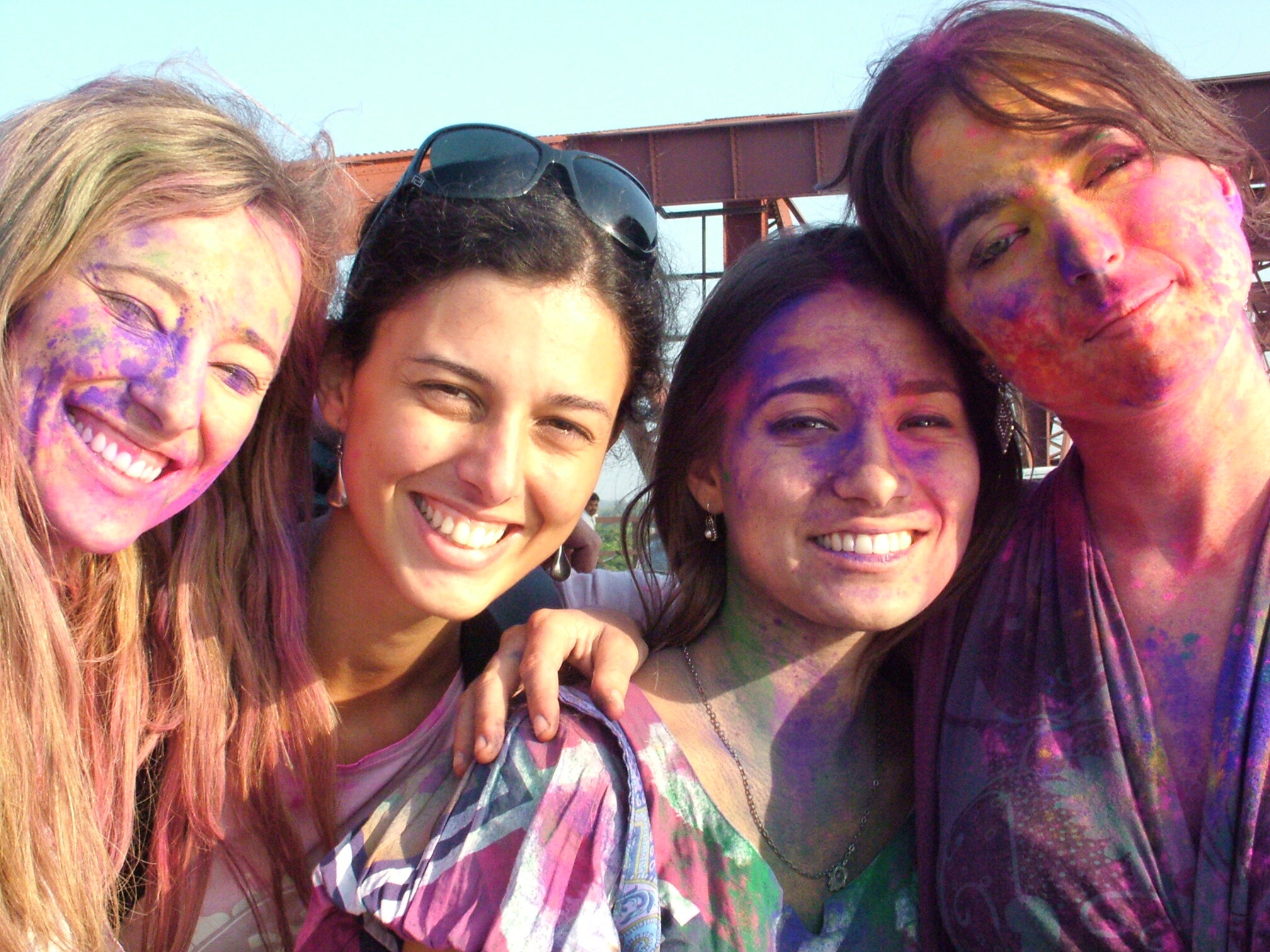BOLLYWOOD DREAM
Competition for the 33rd Mostra Internacional de Cinema em Sao Paulo and the 2010 Pusan International Film Festival.
Synopsis: Luna, Ana and Sofia, are three actress friends who decide to go to India after receiving an invitation from a Bollywood film producer they meet at a film festival in Brazil. They leave their families, children and lives in Brazil to follow this opportunity, but once they arrive in India, they discover that the producer is a farce, who sent them to Chennai in southern India and learn that Bollywood is in Mumbai, on the other side of the country. Without loosing their sense of humor they start playing Brazilian music at a piano bar, working in a community health center and prepare for an audition in Mumbai by taking Bollywood dance lessons from a young boy they hire and traditional Indian acting with a old Indian actress. Little by little, the people they meet and the places they are living in bring to their lives the presence of their mythology with newer questions about their existences, common on that ancestral culture. While trying to get to Mumbai, they take the wrong train and end up in Varanasi. In the holy city by the riverbanks of the Ganges, they witness death being seen as liberation and life being celebrated by small everyday rituals. When they finally arrive in Mumbai for the big audition, their dreams have entirely changed, their lives transformed and the wish to make the audition disappeared. In the midst of Holi, the festival of life and colors, they dance for the last time together before getting separated to go after new dreams, as they get colored by the festival’s vibrant powder colors flung into the air.
Festivals: Sao Paulo International Film Festival, Pusan International Film Festival, Amerasia Film Festival, Delhi International Film Festival, Dialogue of Cultures International Film Festival, San Diego Latino Film Festival, Reel Brazil Film Festival (New Zealand), and others.
Actress, filmmaker and writer, BEATRIZ SEIGNER is the director of the short films “Uma menina como outras Mil” and “Roda Real” (Sao Paulo’s International Short Film festival 2001 and 2004) and “Indias”, about the traditions that are disappearing in India, and writer of the documentaries “Refugee Diaries” and “On the Griot Trail”, about endangered languages and storytelling traditions in Africa and Brazil. As an actress she was in “The Seekers”, directed by Frank Megna and in the new film by the acclaimed Brazilian director Walter Salles’s and Daniela Thomas, “Linha de Passe”.
Cast: Paula Braun, Lorena Lobato and Nataly Galleazzo Cabanas. Director & Script: Beatriz Seigner. Producers: Ram Devineni and Beatriz Seigner. Executive Producer: Santosh Sivan & Amir Naderi. Time: 90 Minutes / Color. Brazil and India. Portuguese, English and Tamil (English subtitles). Status: National release in Brazil, April 28, 2011.
VARIETY: Bollywood Dream Review
A road comedy about a trio of Brazilian actresses on a hare-brained mission to work in Indian musicals, “Bollywood Dream” is slow to start, then comes home strong when the distaff dancers get their groove on. A respectable debut by helmer Beatriz Seigner, this crowd-pleaser should dance its way to plenty of fests, but rough technical edges will likely restrict exposure outside Brazil and India to the smallscreen. Brazilian release is set for February 2011.(By RICHARD KUIPERS)
Thirtysomething gal-pals Sofia (Nataly Cabanas), Luna (Lorena Lobato) and Ana (Paula Braun) arrive in India, only to discover their hotel reservations have vanished, along with a Bollywood producer they’re supposed to contact. More like a downbeat travel docu at first, pic shifts into a much more appealing and lively gear when the ladies find low-rent lodgings with kindly innkeeper Mr. Kumar (Paraneshwa Naiar), and cheeky teenage choreographer Kalya (Kaushik Satish, terrific) starts whipping them into shape. Though handheld camerawork is sometimes very shaky and images are occasionally overexposed, pic is well served by spirited perfs and a terrific soundtrack mixing peppy Bollywood tunes with classical rhythms of sitar, sarod and tabla.
ESTADAO: Sonho bollywoodiano de diretora do Brasil vai até as Índias
Beatriz Seigner apresenta Bollywood Dream, feito com só US$ 20 mil; defeitos do longa viram as maiores virtudes. (Luiz Carlos Merten, de O Estado de S. Paulo)
“Beatriz might have done the best film made in the West about India with only 20 thousand dollars. The superficial and esquematic becomes steps for something deeper – the ephemeral in face of a millenar culture. We can compare Bollywood Dream with El Mariachi, made by Robert Rodriquez with even less money. To like or not to like it is what’s matter the least. The small observations in between the lines are its strength.”
Todos os caminhos levam à Índia. Hollywood consagrou Danny Boyle e sua incursão pelo universo bollywoodiano com Quem Quer Ser Um Milionário? Glória Perez, com raro senso de oportunidade – mas isso ela sempre teve, lembrem-se de O Clone -, cravou um grande êxito na novela das 8, justamente com O Caminho das Índias. Por que criticar a jovem Beatriz Seigner? Se ela tinha um sonho bollywoodiano, é evidente que conseguiu concretizá-lo. Bollywood Dream – O Sonho Bollywoodiano teve no sábado sua primeira sessão na 33ª Mostra. O filme terá novas exibições hoje e quarta-feira. Beatriz pode ter realizado o melhor filme feito no Ocidente sobre a Índia, por apenas US$ 20 mil.
Foi o custo da produção, incluindo o mais difícil – a ida para o Oriente da diretora e de suas três atrizes, Paula Braun, Lorena Lobato e Nataly Cabanas. Num breve encontro com o público, após a projeção – 15 minutos de pergunta e resposta -, Beatriz contou que foi à Índia há seis anos. O país e sua cultura a fascinaram e ela encontrou um produtor (Ram Prasada Devineni) que resolveu bancar seu sonho. Três atrizes brasileiras partem para a Índia na tentativa de fazer carreira em Bollywood. É o lugar do mundo em que mais se produzem filmes, mais do que nos EUA. Elas chegam na cara e na coragem, seguindo o vago convite que um produtor indiano fez a uma integrante do grupo.
Como Beatriz contou, ela tinha um roteiro básico – que foi construído em cima das atrizes, que são suas amigas. Uma delas tem um filho. Há um background dramático, ela deixou o filho no Brasil e, pelo telefone, tem uma discussão com alguém – o pai, o ex-marido? – que a acusa de haver abandonado a criança. Havia, portanto, esse roteiro, mas o filme é resultado principalmente da improvisação e do que Beatriz e suas atrizes iam descobrindo na – e sobre a – Índia. O espectador que descobre agora a existência deste filme e fica curioso pelo resultado precisa ser avisado de que não vai encontrar nada tão profundo – nem visualmente suntuoso – quanto a aventura indiana de Sir David Lean, Passagem para a Índia. Mas Beatriz Seigner, na sua modéstia, também faz uma (pequena) passagem para a Índia.
As melhores cenas de seu filme parecem intuições. Logo de cara, quando as três garotas passam pela imigração, ainda no aeroporto, o oficial que, do País conhece somente a Aquarela do Brasil, acolhe o trio simpaticamente e até ensaia cantar a música famosa de Ari Barroso. O clima é de festa, mas ele pergunta a Paula Braun, atriz de O Cheiro do Ralo, o que ela está fazendo na Índia.Ela pede à amiga que fala inglês que traduza – diz que é atriz, está desempregada, tem um filho para criar e, no fundo, espera resolver sua vida e fazer carreira no cinema. A amiga, esperta, sabe que essas coisas não se dizem a um oficial de imigração. E ela resume o discurso numa sentença mais fácil – elas estão ali fazendo uma viagem, uma peregrinação espiritual.
O público ri, mas é exatamente o que o Beatriz e seu filme estão propondo, ou realizando. Quando uma das garotas filma um rito secular – o lançamento do deus Ganesha no rio-mar -, o indiano anônimo pergunta por que ela faz aquilo. O quê? Filmar. Para eternizar o momento, diz a garota . Mas o rito já é eterno, ele retruca. O filme é cheio desses pequenos momentos. Paula Braun diz que a filmagem foi um permanente exercício de cara de pau, forçando as pessoas – os indianos – a interagirem com a equipe. A lição de interpretação é outro momento exemplar. A atriz ensina a chorar provocando uma lágrima com a maquiagem. Mas a força e intensidade do olhar – “cinema é a melodia do olhar”, dizia Nicholas Ray -, essa é outra aula, mais complicada, que fica para amanhã. O esquemático e o superficial viram degraus para algo mais profundo – o efêmero face a uma cultura milenar. Pode-se comparar Bollywood Dream com El Mariachi, que Robert Rodriguez fez com menos dinheiro ainda (US$ 7 mil). Gostar ou não gostar é o de menos. As pequenas observações nas entrelinhas são o forte.





